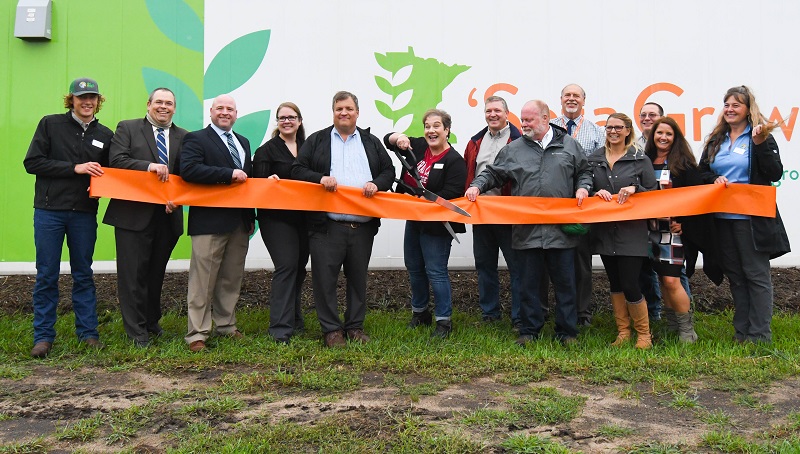Following a year’s delay due to the COVID-19 pandemic, the partners behind ‘Sota Grown gathered last month at the site of their indoor agriculture food project for a celebratory ribbon-cutting event.
‘Sota Grown is an innovative pilot project that’s growing leafy greens inside a renovated shipping container at Central Lakes College’s (CLC) campus in Staples, Minnesota. This collaboration between electric cooperatives, a local college, health care facility, and national research institute intends to demonstrate over a two-year period how indoor crop production using efficient electricity, technology and plant sciences can produce ideal conditions for growth, yield, quantity and consistency.
Representatives from each of the partners — along with special guests, including Thom Peterson, Minnesota’s Commissioner of Agriculture — spoke on the project’s impact on each participating organization, as well as the surrounding community that has benefited by receiving fresh produce grown in the container throughout the last year.
“Thanks to partners and dedicated CLC staff, we have been able to produce well over 1,000 pounds of kale in a year-round capacity,” said Cory Detloff, director of Ag & Energy at CLC. “This project gives us a unique ability to measure energy and water usage, monitor growing conditions, deliver wholesome produce year-round and measure crop output to help determine the financial viability of these systems for other producers.”
Allison Uselman, member and energy services manager at Todd-Wadena Electric Cooperative (TWEC), said that although this project is embracing the beneficial use of electricity to find ways that may help the state’s agriculture community in the future, it is not intended to be a replacement for traditional farming.
“Our cooperative was built by local farmers and our agriculture community continues to play a significant role in our operations,” Uselman said.
One of the factors that went into Great River Energy and the Electric Power Research Institute’s decision to choose TWEC for this pilot project is its location. The region is a “low-income access” area as defined by the United States Department of Agriculture. This means many community members face both economic and distance challenges to access fresh, healthy food on a routine basis.
“Our dedication to empowering health and well-being goes beyond delivering exceptional health care to our patients and residents. It is a commitment to improving the health of the communities we serve,” said Alicia Bauman, director of community health at Lakewood Health System, which delivers ‘Sota Grown produce to more than 600 area residents monthly. “Factors like access to affordable, healthy food are directly related to our ability to achieve whole person well-being.”
The pilot project’s success has already created a blueprint that is being replicated around the state. A few additional projects have sprung up with help from a few of Great River Energy’s member-owner cooperatives. As more electricity generated by the cooperatives is from renewable energy resources, the electricity used to power projects like ‘Sota Grown become cleaner, too.
“Twenty-five percent of the electricity Great River Energy generates today is renewable and, in just two years, that will increase to 50% as we plan to add 900 megawatts of wind energy by the end of 2023,” said Mark Fagan, vice president and chief corporate and member services officer at Great River Energy. “We look forward to seeing the even greater potential indoor food production has in Minnesota’s future, and how our electric cooperatives can be part of it.”
Visit ‘Sota Grown on Facebook to follow along as the project continues to grow fresh produce.


 " data-object-fit="cover">
" data-object-fit="cover">
 " data-object-fit="cover">
" data-object-fit="cover">